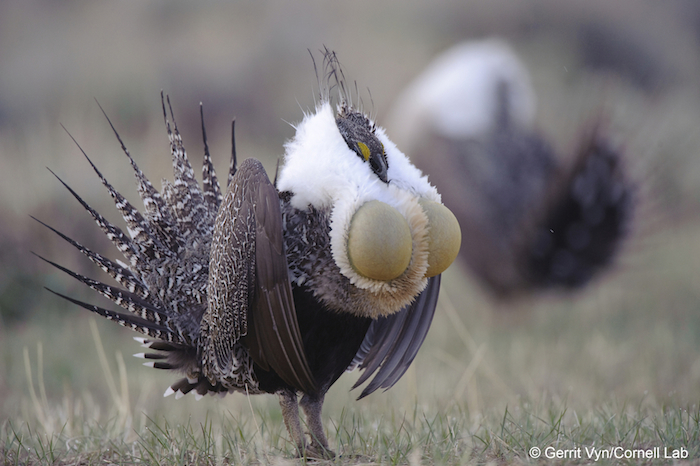
Ithaca, NY — One of the biggest conservation challenges in the nation’s history is coming to a head this year and it is resting on the shoulders of an increasingly rare bird—the Greater Sage-Grouse. The Cornell Lab of Ornithology‘s film, The Sagebrush Sea, reveals the hidden world of this iconic species at a time when its fate is being decided in state houses, agencies, and courtrooms across the West and in the nation’s capital.
The Sagebrush Sea makes its broadcast premiere May 20, on NATURE at 8:00 p.m. Eastern Time/7:00 p.m. Central on PBS. (Check local listings.)
The U.S. Fish & Wildlife Service is under court order to decide by September if the Greater Sage-Grouse should be protected under the Endangered Species Act. If the grouse is listed, states fear it could cost their economies hundreds of millions of dollars in oil and gas revenue and threaten the ranching culture that defines many local communities.
“The listing debate is taking place largely in a vacuum of public understanding about the species and the ecosystem,” says Cornell Lab producer Marc Dantzker, “And that’s where we hope our film can make a real contribution. People who drive by on the highways and even many of the people who live within it, think this vast region that covers parts of 11 western states is empty, but it isn’t.”
At least 250 birds, mammal, and other vertebrates live in the sagebrush region, some of them found nowhere else. The documentary shows this treeless, high desert habitat as few have ever seen it—up close, in stunning ground-level and aerial scenes that bring to light the unexpected diversity of life too easily overlooked.
“Many compare the situation with the Greater Sage-Grouse to what happened with the Northern Spotted Owl, but on a much larger scale,” says Dantzker, referring to the heated battles of the 1990s that pitted Pacific Northwest logging interests against protection of a declining bird species. At one time there were many millions of Greater Sage-Grouse—16 million, by some estimates. Now most estimates are between 200,000 and 300,000.
“Everyone in the country is going to be hearing about the Greater Sage-Grouse in the coming months and we want them to know that it is more than a controversy–it is an amazing national treasure, as splendid as any bird on earth. And it is at the center of an ecosystem that is unique, underappreciated, and embodies the spirit and the romance of the American West,” says principal cinematographer Gerrit Vyn.
The documentary, more than two years in the making, begins on a springtime lek—the open stage where Greater Sage-Grouse males strut and perform their age-old displays, hoping to be one of the fortunate few able to pass on his genes. The females hold all the cards as they stroll the lek with a discerning eye.
The males are captivating with their intricately patterned spiked tail feathers and thin head plumes. Dantzker studied their display for years. He says, “Their intricate strut is just a few seconds long so you need to slow it down to really appreciate it. First they inflate an air sac inside their heavy white neck pouch. Then they strum the pouch’s bristled white feathers with their wings. Lastly, they heave the neck pouch up and pull their heads down, squeezing out two balloons and belting out a pair of ringing pops. There’s nothing like it anywhere on earth.” They do this hundreds of times each day for months, all while defending a territory. With a lifespan of only about four years, males don’t have much time to fulfill the genetic imperative.
The sage-grouse are just one of a suite of animals that has adapted over the eons to survive in this unforgiving landscape, including three other bird species found nowhere else: the Sage Thrasher, Sagebrush Sparrow, and Brewer’s Sparrow. The sage is also home to pronghorn, mule deer, prairie dogs, Golden Eagles, sagebrush lizards, and pygmy rabbits.
“There are ways to balance human land-use needs with the needs of the animals that depend on the sage to survive,” says Dantzker. “We produced this documentary because we believe that understanding and appreciating the region’s natural beauty will make people more willing to take a balanced approach toward development and at the same time make conservation and preservation a priority.”
